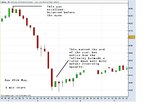jon1971
Well-known member
- Messages
- 495
- Likes
- 28
OK, this is all making very good sense, and to increase probability I should also be looking for the trade to be in tune with the longer term time frame trends (weekly and monthly) in the case of £/$ currently this would clearly be a long position.
Thanks to all who have replied to my questions.
Jon
Thanks to all who have replied to my questions.
Jon


